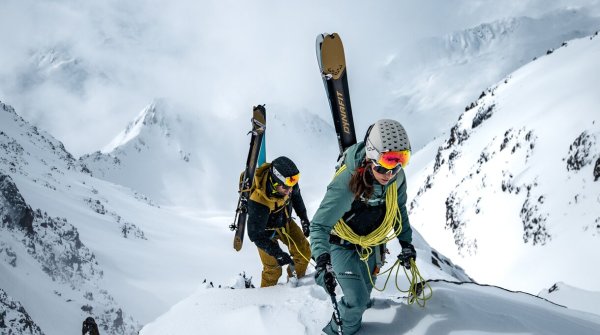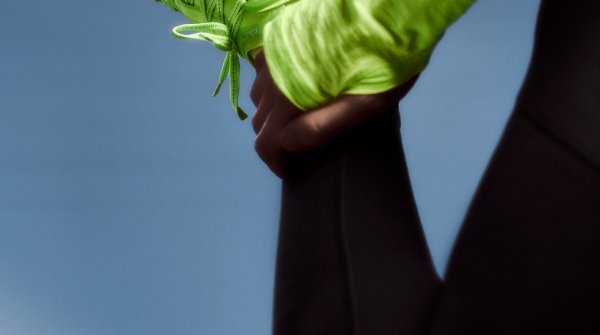The outdoor market is under pressure at the moment, but Merrell seems to have a solid strategy. Can you let us in a little?
Tim Selby: The brand has been going through a transformation over the past few years. Before 2019, we were quite traditional — I used to joke that our product meetings were “40 shades of brown.” But consumer research showed a clear shift: new participants didn’t want that classic, heritage-only approach. If we hadn’t changed, the market would have become increasingly difficult.
We began a journey to reposition Merrell as a more athletic outdoor brand. If you visit our website today, you’ll see that shift clearly. The results have been strong and we’ve achieved double-digit growth over the last five years.
What is Merrell about today?
Selby: Our heritage has always been about inclusion. We were never a “top of the mountain” brand but one for everyone. Today, our mantra is simple: “the outdoors is for everybody.” We now talk more about celebrating the “outside”, that everyday space beyond your front door, rather than only the extreme outdoors.
Lots of brands still focus on the summit, but only a small percentage of people ever get there. The “outside” is a much broader, more relatable space. And you know, the outside is far bigger market than the outdoors. Consumers no longer think of heavy leather boots they wear twice a year; they want products they can use on multiple occasions, from trail to town.

What changes in the market do you observe at the moment?
Selby: We’re seeing a clear move toward versatility. Consumers in their 30s want shoes that fit multiple occasions — something that works for hiking, travel, or daily life. If they are serious about it, they still buy that technical mountain boot for the occasion. But even when I was in the Alps this summer, almost everyone wore trail running or hiking shoes; hardly anyone wore leather boots. And when you went out afterwards, also in bigger towns, everybody was pairing the same type of shoes with jeans.
Outdoor retailers are adapting, embracing colour, style, and crossover aesthetics. They are becoming more of an outside than a classic outdoor retailer. Collaborations with fashion brands are also opening new spaces, helping outdoor products become part of everyday wardrobes.
What does this mean for retail?
Selby: Well, in terms of these capsules with their smaller numbers, everybody wants to get their hands on these pairs and we have seen some really meaningful collaborations in recent years. But how you segment your line is super critical. In the old days, you could just bring out four colour ways and sell these everywhere. But it doesn’t work like that any more. Today, you need to bring the right product for the right channel, and that is where the challenge lies. If you don’t have the product in place that the consumer in that channel wants, the price will be off, as you need to discount there.
Also, the cycles have changed: we are not talking about maybe three months interest now. It’s about regular drops of buying and selling out and the consumer moving onto the next one from there. You need to keep the freshness because why else should consumers come to your store?
And it’s not only us that are doing this research, it is the big retailers as well, crunching data and getting more of a segmentation on. They want to talk to different consumers in different ways. And this is exactly where we think the market is going. We’ll have to be more tailored and more sophisticated, more targeted also. And I think that is a good thing as it will elevate the outdoor value.

How does customer experience and community play into that?
Selby: I think the retail landscape will further consolidate and change from transactional to experiential. Brands and retailers need to collaborate more on events, storytelling, and community engagement. For the future, it’s all about elevating the experience in retail, and also how brands and retail partners come together to do it, as brands are also using the space for launching events and building community. I believe that delivering customer experience and having a longer dwell time in store is key, too. Inviting local schools or hosting in-store activities helps create lasting connections.
Beyond retail, community runs are thriving. You do not only see that in retail. Run clubs, for example, have made people feel included and connected, with running becoming a lifestyle choice rather than a purely competitive sport. In the UK, events like *Love Trails* combine running with music and culture and create a new kind of community experience and I think we will see more of that too, as the need for connection and shared identity is not going to slow down.
You’ve touched on trail running briefly. How do you explain the trend in light of strong urban markets?
Selby: Trail running shows no sign of slowing down. It will be a major growth area in coming years. As running grows overall, consumers are bringing that passion outdoors. They may not be going top of the mountain, but they still want technical gear like Gore-Tex and Vibram and show that move outdoors via brands supporting that technical feel.
Interestingly, about 60% of trail running consumers are urban dwellers. They might spend two weeks a year in the Alps, but for the rest of the time, they’re training near home and then maybe heading to the pub afterward. The trend is driven from urban settings. Running silhouettes have become part of daily style, retailers are bringing in new ideas here and consumers love that technical edge of trail footwear.
Merrell is also dedicating funds and effort into getting more people outside. Can you talk a little bit more about that?
Selby: Yes, we believe the outdoors should be accessible to everyone. As research shows, only 15 minutes outdoors can have a massive impact on metal health and our general wellbeing, which is why we want to bring more people outside. Our CSR programs focus on community, belonging, and accessibility. That includes funding projects that bring underprivileged kids from cities into nature, helping communities build local trails, and supporting groups that use outdoor activity to improve mental health.
We have also run initiatives for refugees and maintain a Merrell Fund to support grassroots organizations and welcome applications from all over Europe.
Last question: How do you see the future of the industry and how does ISPO 2025 fit into that for you?
Selby: Running will continue to grow, and as an industry, we need to stay close and talk to our consumers to keep evolving and remain relevant with them. Despite economic challenges, the outdoor sector has a strong point of view and a meaningful role in society.
As for ISPO, we’re excited to see how the show evolves alongside the market. The new concept aligns closely with what we’ve discussed — the intersection of outdoor and lifestyle. That’s exactly where we see the future, and we’re thrilled to return to ISPO in 2025 to showcase that vision.
From the interview with Tim Selby from Merrell, it is clear that the sports and outdoor industry is undergoing a fundamental change. Consumers today are looking for versatile products that combine function, style and suitability for everyday use. Outdoor is becoming a lifestyle, not just a sporting activity. Brands that focus on authenticity, inclusion and community are creating real relevance. For retailers and manufacturers, this means less product thinking and more experience, cooperation and meaning.
At ISPO 2025, you can experience for yourself how Merrell is shaping this change. As an exhibitor, the brand will be showing how outdoor and lifestyle come together seamlessly with new products that combine versatility, function and design. From NOV 30. - DEC. 02 in Munich.
- Target group change: The classic distinction between outdoor and everyday life is disappearing. People want products that accompany them from the trail to the city - functional, comfortable and stylish at the same time.
- New brand identity: Authenticity counts more than perfection. Brands that emphasize diversity and accessibility create real closeness to their community.
- Retail in transition: Retailers need to create experiences, not just sell. Those who offer events, storytelling and encounters remain relevant.
- Cooperation as a door opener: Crossover with fashion, culture or music helps to bring outdoor products into everyday life and to new target groups.
- Community and purpose: Brands that become part of local initiatives and bring people outdoors create trust and asense of belonging.
- Future outlook: The sports industry is moving from "outdoor" to "outside" - less performance, more lifestyle

 Sports BusinessSki Mountaineering Goes Olympic: What Milano-Cortina 2026 Means
Sports BusinessSki Mountaineering Goes Olympic: What Milano-Cortina 2026 Means
- ISPO awards
- Mountain sports
- Bike
- Design
- Retail
- Fitness
- Health
- ISPO Job Market
- ISPO Munich
- ISPO Shanghai
- Running
- Brands
- Sustainability
- Olympia
- OutDoor
- Promotion
- Sports Business
- ISPO Textrends
- Triathlon
- Water sports
- Winter sports
- eSports
- SportsTech
- OutDoor by ISPO
- Heroes
- Transformation
- Sport Fashion
- Urban Culture
- Challenges of a CEO
- Trade fairs
- Sports
- Find the Balance
- Product reviews
- Newsletter Exclusive Area
- Magazine


